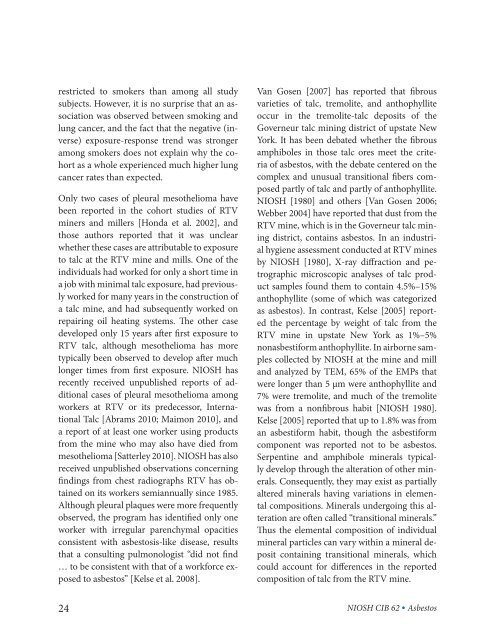Asbestos Fibers and Other Elongate Mineral Particles: State of the ...
Asbestos Fibers and Other Elongate Mineral Particles: State of the ...
Asbestos Fibers and Other Elongate Mineral Particles: State of the ...
- No tags were found...
You also want an ePaper? Increase the reach of your titles
YUMPU automatically turns print PDFs into web optimized ePapers that Google loves.
estricted to smokers than among all study<br />
subjects. However, it is no surprise that an association<br />
was observed between smoking <strong>and</strong><br />
lung cancer, <strong>and</strong> <strong>the</strong> fact that <strong>the</strong> negative (inverse)<br />
exposure-response trend was stronger<br />
among smokers does not explain why <strong>the</strong> cohort<br />
as a whole experienced much higher lung<br />
cancer rates than expected.<br />
Only two cases <strong>of</strong> pleural meso<strong>the</strong>lioma have<br />
been reported in <strong>the</strong> cohort studies <strong>of</strong> RTV<br />
miners <strong>and</strong> millers [Honda et al. 2002], <strong>and</strong><br />
those authors reported that it was unclear<br />
whe<strong>the</strong>r <strong>the</strong>se cases are attributable to exposure<br />
to talc at <strong>the</strong> RTV mine <strong>and</strong> mills. One <strong>of</strong> <strong>the</strong><br />
individuals had worked for only a short time in<br />
a job with minimal talc exposure, had previously<br />
worked for many years in <strong>the</strong> construction <strong>of</strong><br />
a talc mine, <strong>and</strong> had subsequently worked on<br />
repairing oil heating systems. The o<strong>the</strong>r case<br />
developed only 15 years after first exposure to<br />
RTV talc, although meso<strong>the</strong>lioma has more<br />
typically been observed to develop after much<br />
longer times from first exposure. NIOSH has<br />
recently received unpublished reports <strong>of</strong> additional<br />
cases <strong>of</strong> pleural meso<strong>the</strong>lioma among<br />
workers at RTV or its predecessor, International<br />
Talc [Abrams 2010; Maimon 2010], <strong>and</strong><br />
a report <strong>of</strong> at least one worker using products<br />
from <strong>the</strong> mine who may also have died from<br />
meso<strong>the</strong>lioma [Satterley 2010]. NIOSH has also<br />
received unpublished observations concerning<br />
findings from chest radiographs RTV has obtained<br />
on its workers semiannually since 1985.<br />
Although pleural plaques were more frequently<br />
observed, <strong>the</strong> program has identified only one<br />
worker with irregular parenchymal opacities<br />
consistent with asbestosis-like disease, results<br />
that a consulting pulmonologist “did not find<br />
… to be consistent with that <strong>of</strong> a workforce exposed<br />
to asbestos” [Kelse et al. 2008].<br />
24<br />
Van Gosen [2007] has reported that fibrous<br />
varieties <strong>of</strong> talc, tremolite, <strong>and</strong> anthophyllite<br />
occur in <strong>the</strong> tremolite-talc deposits <strong>of</strong> <strong>the</strong><br />
Governeur talc mining district <strong>of</strong> upstate New<br />
York. It has been debated whe<strong>the</strong>r <strong>the</strong> fibrous<br />
amphiboles in those talc ores meet <strong>the</strong> criteria<br />
<strong>of</strong> asbestos, with <strong>the</strong> debate centered on <strong>the</strong><br />
complex <strong>and</strong> unusual transitional fibers composed<br />
partly <strong>of</strong> talc <strong>and</strong> partly <strong>of</strong> anthophyllite.<br />
NIOSH [1980] <strong>and</strong> o<strong>the</strong>rs [Van Gosen 2006;<br />
Webber 2004] have reported that dust from <strong>the</strong><br />
RTV mine, which is in <strong>the</strong> Governeur talc mining<br />
district, contains asbestos. In an industrial<br />
hygiene assessment conducted at RTV mines<br />
by NIOSH [1980], X-ray diffraction <strong>and</strong> petrographic<br />
microscopic analyses <strong>of</strong> talc product<br />
samples found <strong>the</strong>m to contain 4.5%–15%<br />
anthophyllite (some <strong>of</strong> which was categorized<br />
as asbestos). In contrast, Kelse [2005] reported<br />
<strong>the</strong> percentage by weight <strong>of</strong> talc from <strong>the</strong><br />
RTV mine in upstate New York as 1%–5%<br />
nonasbestiform anthophyllite. In airborne samples<br />
collected by NIOSH at <strong>the</strong> mine <strong>and</strong> mill<br />
<strong>and</strong> analyzed by TEM, 65% <strong>of</strong> <strong>the</strong> EMPs that<br />
were longer than 5 µm were anthophyllite <strong>and</strong><br />
7% were tremolite, <strong>and</strong> much <strong>of</strong> <strong>the</strong> tremolite<br />
was from a nonfibrous habit [NIOSH 1980].<br />
Kelse [2005] reported that up to 1.8% was from<br />
an asbestiform habit, though <strong>the</strong> asbestiform<br />
component was reported not to be asbestos.<br />
Serpentine <strong>and</strong> amphibole minerals typically<br />
develop through <strong>the</strong> alteration <strong>of</strong> o<strong>the</strong>r minerals.<br />
Consequently, <strong>the</strong>y may exist as partially<br />
altered minerals having variations in elemental<br />
compositions. <strong>Mineral</strong>s undergoing this alteration<br />
are <strong>of</strong>ten called “transitional minerals.”<br />
Thus <strong>the</strong> elemental composition <strong>of</strong> individual<br />
mineral particles can vary within a mineral deposit<br />
containing transitional minerals, which<br />
could account for differences in <strong>the</strong> reported<br />
composition <strong>of</strong> talc from <strong>the</strong> RTV mine.<br />
NIOSH CIB 62 • <strong>Asbestos</strong>

















